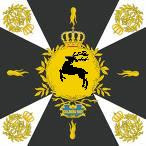So, a victory for Luftberg to go alongside Vogelhof and avenge the failure outside Flussburg! Quite an achievement too, as the Aschenbach army was depleted far past the point where it could fight another battle this campaign.
Aschenbach really had their plan collapse through having no cavalry on their attacking wing. It sounds obvious, but I’d never quite realised before now how important cavalry is in delivering a speedy attack, protecting your own troops as they march as well as protecting their flank. As it turned out, Luftberg were able to respond fast enough to form a new line and defeat the attack. Just as at Vogelhof, the Aschenbach army’s failure – or at least a lot of it’s problems – can be largely attributed to it’s pre-battle deployment.
The Luftberg army did perform quite well, and a bit of this was down to the rules and the Elector’s command dice – he rolled remarkably well, typically getting just as many as his opponent did, which is lucky of him. Plus, on a practical note on improving ‘gamesmanship’ I’ve learned that Luftberg command dice need to be lavished on control activation, and not hoarded for possible combat rerolls.
As for leaders, General Reich Graf James Louis von Beerstein and Major Ungaurn both proved themselves capable performers, which sounds like mild praise but it definitely puts them above the average for Luftberg sub-commanders! (And the Beerstein Infantry of course were excellent in holding off the Hirschburger grenadiers long enough to let them and their neighbouring units shoot them down.) As for the notable casualty of the day, the fate of Conrad von Hentsch (potential heir to Luftberg, illegitimate son of the Elector, scion of a powerful family, most talented commander in the Luftberg army, etc.) is still to be decided. He’s become a casualty on the day, but I’ve not yet worked up the nerve to decide his ultimate fate by a dice roll. For now, the surgeons are at work and shall report back shortly…
Subscribe to:
Post Comments (Atom)


No comments:
Post a Comment